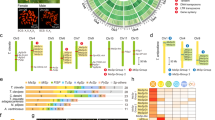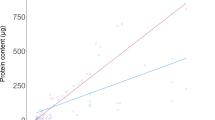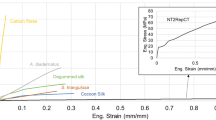Abstract
Silk proteins were taken from the major ampullate glands found in the abdomens of Nephila clavata spiders that were collected on different days during an autumn season in Japan. The molecular weights of the silk proteins taken from 125 spiders were determined under a reduced state using electrophoresis. It was found that the molecular weight of N. clavata spider silk protein changed depending on the time period during the autumn season and showed a peak value of ~300 kDa during mating season. However, the molecular weight of N. clavata spider silk protein was, on average, ~270 kDa except during mating season. Such a peak in the molecular weight for female N. clavata may be ascribed to the necessity for building mechanically strong orb-webs, which consist of silk with relatively large proteins for the purpose of accepting many male spiders.
Similar content being viewed by others
Log in or create a free account to read this content
Gain free access to this article, as well as selected content from this journal and more on nature.com
or
References
Foelix, R. F . in Biology of Spiders (ed. Foelix, R. F.) (Harvard University Press, London, England, 1982).
Osaki, S. Spider silk as mechanical lifeline. Nature 384, 419–419 (1996).
Osaki, S. Is the mechanical strength of spider's drag-lines reasonable as lifeline? Int. J. Biol. Macromol. 24, 283–287 (1999).
Work, R. W. & Morosoff, N. S. A physic-chemical study of the supercontraction of spider major ampullate silk fibers. Tex. Res. J. 52, 349–356 (1982).
Gosline, J. M., Denny, M. W. & DeMond, M. E. Spider silk as rubber. Nature 309, 551–552 (1984).
Vollrath, F. Biology of spider silk. Int. J. Biol. Macromol. 24, 81–88 (1999).
Osaki, S. & Ishikawa, R. Determination of elastic modulus of spider’s silks. Polym. J. 34, 25–29 (2002).
Osaki, S. Thermal properties of spider’s thread. Acta Arachnol. 37, 69–75 (1989).
Osaki, S. Aging of spider silks. Acta Arachnol. 43, 1–4 (1994).
Osaki, S. Effects of ultraviolet rays and temperature on spider silks. Acta Arachnol. 46, 1–4 (1997).
Osaki, S., Yamamoto, K., Kajiwara, A. & Murata, M. Evaluation of the resistance of spider silk to ultraviolet irradiation. Polym. J. 36, 623–627 (2004).
Osaki, S. Ultraviolet rays mechanically strengthen spider’s silks. Polym. J. 36, 657–660 (2004).
Kuhbier, J. W., Reimers, K., Kasper, C., Allmeling, C., Hilmer, A., Menger, B., Vogy, P. M. & Radtke, C. Fist investigation of spider silk as a braided microsurgical suture. J. Biomed. Mat. Res. Pt. B Appl. Biomat. 97, 381–37 (2011).
Osaki, S. Spider silk violin strings with a unique packing structure generate a soft and profound timbre. Phys. Rev. Lett. 108, 154301–154305 (2012).
Lazaris, A., Arcidiacono, S., Huang, Y., Zhou, J.-F., Duguay, F., Chretien, N., Welsh, E. A., Soares, J. W. & Karatzas, C. Spider silk fibers spun from soluble recombinant silk produced in mammalian cells. Science 295, 472–476 (2002).
Scheibel, T. Spider silks: recombinant synthesis, assembly, spinning, and engineering of synthetic proteins. Microb. Cell Fact. 3, 14 (2004).
Sponner, A., Schlott, B., Vollrath, F., Unger, E., Grosse, F. & Weisshart, K. Characterization of the protein components of Nephila clavipes fragline silk. Biochemistry 44, 4727–4736 (2005).
Mello, C. M., Senecal, K., Yeung, B., Vouros, P. & Kaplan, D. in Silk Polymers Materials Science and Biotechnology (eds Kaplan, D., Adams, W. W., Farmer B. & Viney C.) 967–979 (American Chemical Society, Washington, USA, 1994).
Hakimi, O., Knight, D. P., Vollrath, F. & Vadgama, P. Spider and mulberry silkworm silks as compatible biomaterials. Compos. Pt. B. Eng. 38, 324–337 (2007).
Jackson, C. & O’Brien, J. P. Molecular weight distribution of Nephila clavipes dragline silk. Macromoleules 28, 5975–5977 (1995).
Vollrath, F. & Knight, D. P. Liquid crystalline spinning of spider silk. Nature 410, 541–548 (2001).
Sponner, A., Unger, E., Grosse, F. & Weisshart, K. Conserved C-termini of spidroins are secreted by the major ampullate glands and retained in the silk thread. Biomacromolecules 5, 840–845 (2004).
Matsuhira, T., Yamamoto, K. & Osaki, S. Effects of UV-irradiation on the molecular weight of spider silk. Polym. J. 45, 1167–1169 (2013).
Matsuhira, T. & Osaki, S. Molecular weight of Nephila clavata spider silk. Polym. J. 47, 456–459 (2015).
Osaki, S. Safety coefficient of the mechanical lifeline of spiders. Polym. J. 35, 261–265 (2003).
Osaki, S. Seasonal change in color of spider's silk. Acta Arachnol. 38, 21–28 (1989).
Warwicker, J. O. Comparative studies of fibroins. II. The crystal structures of various fibroins. J. Mol. Biol. 2, 350–362 (1960).
Smith, C. W. & Valcarcel, J. Alternative pre-mRNA splicing: the logic 0f combinatorial control. Trends Biochem. Sci. 25, 381–388 (2000).
Breitbrart, R. E., Andreadis, A. & Nadal-Ginard, B. Alternative splicing: a ubiquitous mechanism for the generation of multiple protein isoform from single genes. Annu. Rev. Biochem. 56, 467–495 (1987).
Guzeloglu-Kayisli, O., Lalioti, M. D., Babayev, E., Torrealday, S., Karakaya, C. & Seli, E. Human embryonic poly(A)-binding protein (EPAB) alternative splicing is differentially regulated in human oocytes and embryos. Mol. Hum. Reprod. 20, 59–65 (2014).
Couble, P., Michaille, J. J., Garel, A., Couble, M. L. & Prudhomme, J. C. Developmental switches of sericin mRNA splicing in individual cells of Bombyx mori silk gland. Dev. Biol. 124, 431–440 (1987).
Acknowledgements
This work was supported by the JSPS KAKENHI grant numbers 24655105 and 25288102. The authors are grateful to Professor Hajime Mori of the Kyoto Institute of Technology for kind supply of silkwoms.
Author information
Authors and Affiliations
Corresponding author
Ethics declarations
Competing interests
The authors declare no conflict of interest.
Additional information
Supplementary Information accompanies the paper on Polymer Journal website
Supplementary information
Rights and permissions
About this article
Cite this article
Osaki, S., Yamamoto, K., Matsuhira, T. et al. The effects of seasonal changes on the molecular weight of Nephila clavata spider silk. Polym J 48, 659–663 (2016). https://doi.org/10.1038/pj.2015.138
Received:
Revised:
Accepted:
Published:
Issue date:
DOI: https://doi.org/10.1038/pj.2015.138



